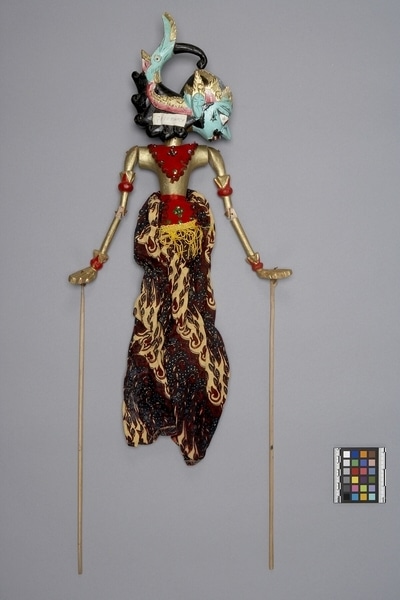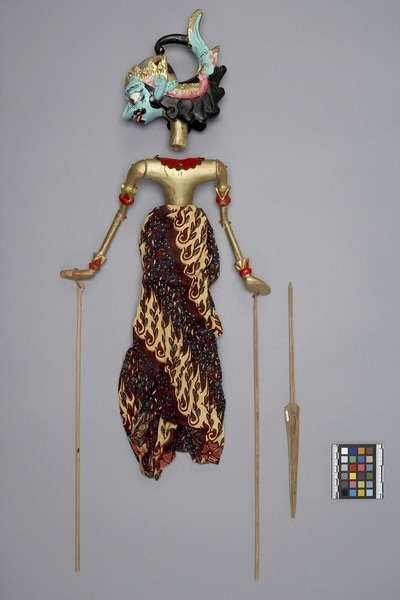Rod Puppet Item Number: Ib391 a-c from the MOA: University of British Columbia


Description
Three-dimensional male humanoid figure (part a); large head (part b) and jointed arms attached to controlling rods and a single long pointed rod (part c). Green face (Bima type) positioned downwards with wedge shaped nose, bulging white eyes with red irises, red open lips and white exposed teeth. Large moustache, beard, facial detail in black. Small upswept curl (gelung supit urang) headdress in black with gold diadem and lungsen outlining grey frontal area. Red and gold sumping below slender green Garuda Mungkur with siyung jawi, in red and gold. Long black hair in six curls. Gold neck and upper torso; two red and gold ornaments on each arm at bicep and wrist. Hands held flat and bent back at wrist. Red chest covering and apron with brown wavy trim, sequins and beads. Apron has red waistband and long yellow fringe at bottom. Long batik skirt in beige with blue and purple. Two pieces of lined white paper with ink inscription (Gatot Gaca) glued to hair at left and front of skirt at left.
History Of Use
Javanese puppetry as an art form probably developed by the 11th century. Wayang golek puppets of western Java appeared during the 16th century. Originally the plays depicted Javanese mythology, but after the Indian conquest of Java the Hindu epics, Ramayana and Mahabharata, were incorporated into the cycles, which comprise about 200 plays. A dalang (puppet master) performs the plays to celebrate important occasions, usually in three acts, with vocal and instrumental accompaniment. Typically they serve a moral and religious purpose, and more recently, one of political commentary. Gatot Kaca is the son of Bima, one of the five Pandawa brothers found in conflict with their usurpers, the Kurawas, in the Mahabharata cycle of plays. He is known for his bravery and loyalty, and the ability he shares with his father, flight. He is found in almost all sets. Gandamana is a minister or advisor (patih) also found in the Mahabharata cycle.
Cultural Context
Theatrical performance.
Iconographic Meaning
Each puppet is characterized by its wanda, a Javanese word which describes the specific mixture of elements of size, form, colour, ornamentation and carving. Green face may suggest calmness or maturity. Bulging red eyes and large features indicate aggressiveness and are not refined. Hands, position of face, arm ornaments, and headdress indicative of nobility, virtue, and wealth. Identified (reliably?) as Gatot Kaca; however, does not match standard figure. Unless a radical variant, puppet is more likely Gandamana, who it resembles closely.
Item History
- Made in Java, Indonesia
- Owned by Donald Bone before January 4, 1980
- Received from Donald Bone (Seller) and Museum of Anthropology Donations Fund (Funding source) on January 4, 1980
What
- Name
- Rod Puppet
- Identification Number
- Ib391 a-c
- Type of Item
- puppet
- Material
- paint, fibre, wood and cotton fibre
- Manufacturing Technique
- carved, tied, sewn, woven and painted
- Part A
- height 69.0 cm, width 14.0 cm, depth 10.0 cm
- Part B
- height 23.0 cm, width 10.1 cm, depth 16.7 cm
- Part C
- height 36.0 cm, width 2.8 cm, depth 0.7 cm
Who
- Culture
- Sundanese
- Previous Owner
- Donald Bone
- Received from
- Donald Bone (Seller) and Museum of Anthropology Donations Fund (Funding source)
Where
- Holding Institution
- MOA: University of British Columbia
- Made in
- Java, Indonesia
When
- Ownership Date
- before January 4, 1980
- Acquisition Date
- on January 4, 1980
Other
- Condition
- fair
- Accession Number
- 0586/0010 a-c